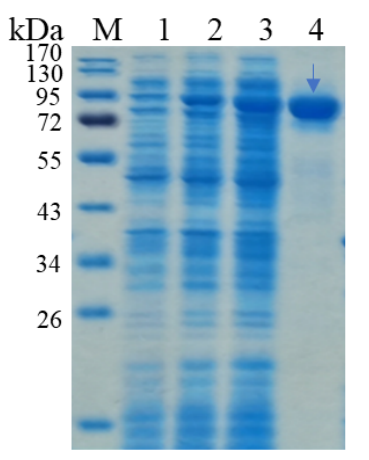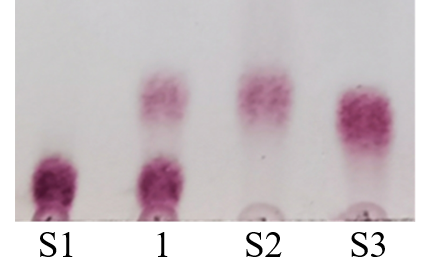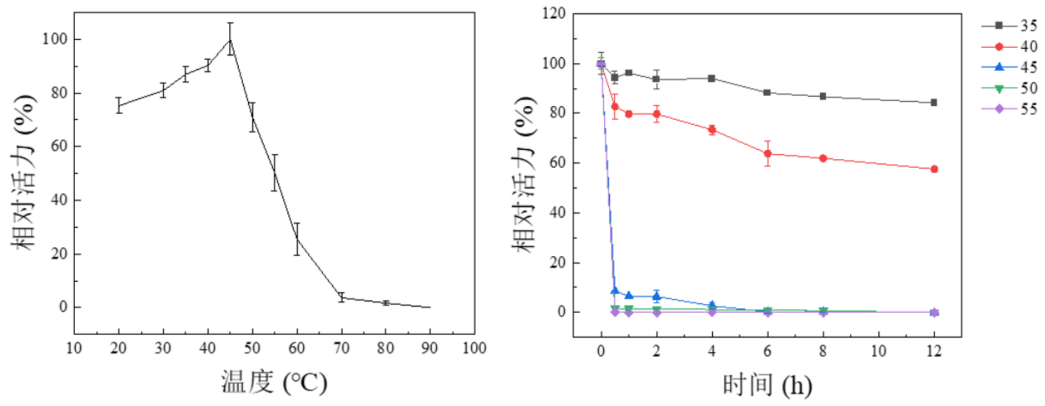PmGlu3B(exo-β-Glucosidase)
PmGlu3B
Ex-Glu0325
(EC.3.2.1.21) exo-β-Glucosidase
CAZy Family: GH3
PROPERTIES
1. ELECTROPHORETIC PURITY
-Single band on SDS-gel electrophoresis (MW ~82 kDa)

Figure 1. Electrophoresis analysis of PmGlu3B. M, molecular weight marker (PageRuler Prestained Protein Ladder, Thermo Scientific); lane 1, culture lysate before IPTG induction; lane 2, culture lysate after IPTG induction; lane 3, PmGlu3B purified from Ni sepharose fastflow column.
2. SPECIFIC ACTIVITY
2.23 U/mg protein (on pNP-β-glu) at pH 6.0 and 45°C
One Unit of pNP-β-glu activity is defined as the amount of enzyme required to release one μg of glucose per minute from pNP-β-glu (5 mM) in phosphate buffer (50 mM) pH 6.0.
3. RELATIVE RATES OF HYDROLYSIS OF SUBSTRATES
Table 1. Relative activity of PmGlu3B on different substrates.
Substrate |
Relative activity (±SD) |
pNPβGlc |
100±0.0 |
pNPβGal |
_ |
pNPβMan |
_ |
pNPβXyl |
_ |
pNPαGlc |
_ |
pNPαGal |
_ |
pNPαMan |
_ |
pNPαAraf |
_ |
pNPαArap |
_ |

Figure 2. Sophorose (Glc-β-1,2-Glc), Laminaribiose (Glc-β-1,3-Glc), Cellobiose (Glc-β-1,4-Glc) and Gentiobiose (Glc-β-1,6-Glc) were selected as substrates to detect substrate selectivity of PmGlc3B. PmGlc3B can weakly hydrolyze Gentiobiose, indicating that PmGlc3B is exo-β-1,6-glucosidase.

Figure. 3. Analysis of ginsenosidase activity of PmGlc3A by TLC. S1, standards of Rb1; S2, standards of Rd; S3, standards of GYP XVII;1, transformed products of Rb1. PmGlc3B can only hydrolyze Rb1 weakly to Rd, and hydrolyze β-1,6-glucosidic bond at C-20 of Rb1. The hydrolysis results are consistent with those of glucosamine selectivity. PmGlc3B is a β-1,6-glucosidase with good specificity.
4. PHYSICOCHEMICAL PROPERTIES
pH Optima: 6.0
pH Stability: 5.0-9.0
Temperature Optima: 45 °C
Temperature Stability: 35-40 °C

Figure 4. Effect of pH on activity (a) and stability (b) of PmGlu3B using pNP-Glu as substrate. The optimal pH (a) was determined at different pH from 2 to 11. The maximum activity obtained was defined as 100% activity. Thermal stability was determined by incubating the enzyme for 24 h at different pH. The activity of the enzyme before incubation was defined as 100%. Results are presented as means ± standard deviations(n = 3).

Figure 5. Effect of temperature on activity (a) and stability (b) of PmGlu3B using pNP-Glu as substrate. The optimal temperature (a) was determined at different temperatures from 20 to 90℃. The maximum activity obtained was defined as 100% activity. Thermal stability was determined by incubating the enzyme for 12 h at different temperatures. The activity of the enzyme before incubation was defined as 100%. Results are presented as means ± standard deviations(n = 3).
5. STORAGE CONDITIONS
The enzyme should be stored at -20°C. For assay, this enzyme should be diluted in phosphate buffer (20 mM) pH 6.0. Swirl to mix the enzyme immediately prior to use.
6. REFERENCES
[1]张国晶.浸麻类芽孢杆菌中葡甘露聚糖降解酶重组表达及功能研究[D].东北师范大学,2022.
[2]孟嘉仪,张国晶,原野.浸麻类芽孢杆菌葡甘露聚糖降解酶的异源表达及功能研究.微生物学报,2023,63(08):3129-3143.


